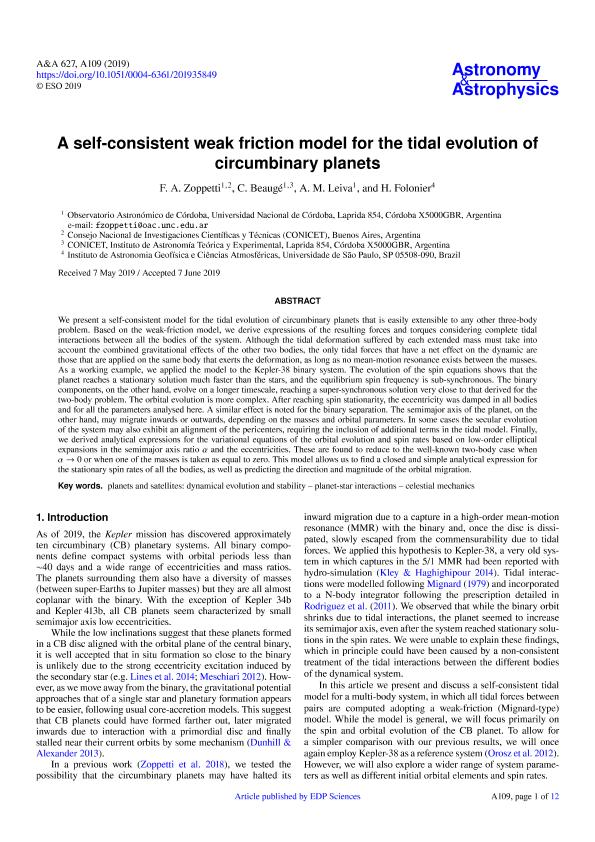Artículo
A self-consistent weak friction model for the tidal evolution of circumbinary planets
Fecha de publicación:
07/2019
Editorial:
EDP Sciences
Revista:
Astronomy and Astrophysics
ISSN:
0004-6361
e-ISSN:
1432-0746
Idioma:
Inglés
Tipo de recurso:
Artículo publicado
Clasificación temática:
Resumen
We present a self-consistent model for the tidal evolution of circumbinary planets that is easily extensible to any other three-body problem. Based on the weak-friction model, we derive expressions of the resulting forces and torques considering complete tidal interactions between all the bodies of the system. Although the tidal deformation suffered by each extended mass must take into account the combined gravitational effects of the other two bodies, the only tidal forces that have a net effect on the dynamic are those that are applied on the same body that exerts the deformation, as long as no mean-motion resonance exists between the masses. As a working example, we applied the model to the Kepler-38 binary system. The evolution of the spin equations shows that the planet reaches a stationary solution much faster than the stars, and the equilibrium spin frequency is sub-synchronous. The binary components, on the other hand, evolve on a longer timescale, reaching a super-synchronous solution very close to that derived for the two-body problem. The orbital evolution is more complex. After reaching spin stationarity, the eccentricity was damped in all bodies and for all the parameters analysed here. A similar effect is noted for the binary separation. The semimajor axis of the planet, on the other hand, may migrate inwards or outwards, depending on the masses and orbital parameters. In some cases the secular evolution of the system may also exhibit an alignment of the pericenters, requiring the inclusion of additional terms in the tidal model. Finally, we derived analytical expressions for the variational equations of the orbital evolution and spin rates based on low-order elliptical expansions in the semimajor axis ratio α and the eccentricities. These are found to reduce to the well-known two-body case when α → 0 or when one of the masses is taken as equal to zero. This model allows us to find a closed and simple analytical expression for the stationary spin rates of all the bodies, as well as predicting the direction and magnitude of the orbital migration.
Archivos asociados
Licencia
Identificadores
Colecciones
Articulos(IATE)
Articulos de INST.DE ASTRONOMIA TEORICA Y EXPERIMENTAL
Articulos de INST.DE ASTRONOMIA TEORICA Y EXPERIMENTAL
Citación
Zoppetti, Federico Andrés; Beauge, Cristian; Leiva, A. M.; Folonier, H.; A self-consistent weak friction model for the tidal evolution of circumbinary planets; EDP Sciences; Astronomy and Astrophysics; 627; A109; 7-2019; 1-12
Compartir
Altmétricas




